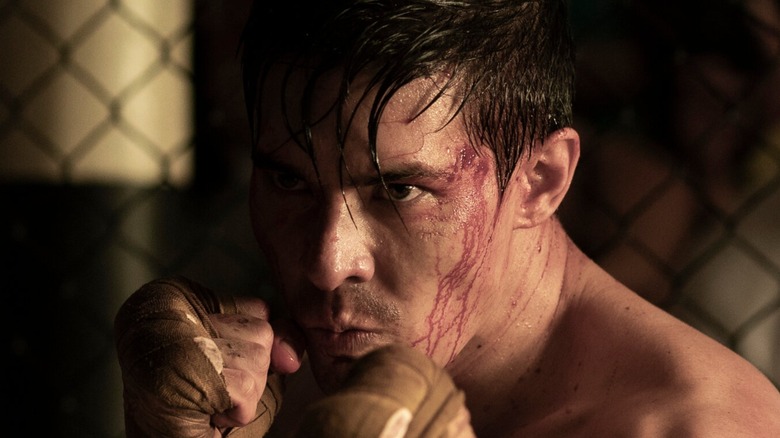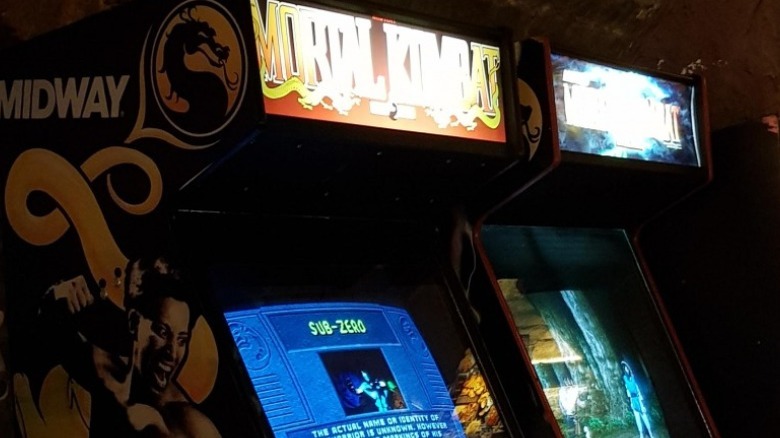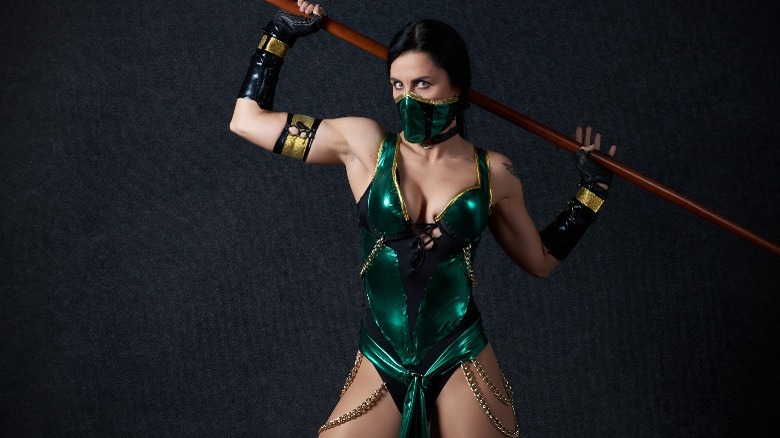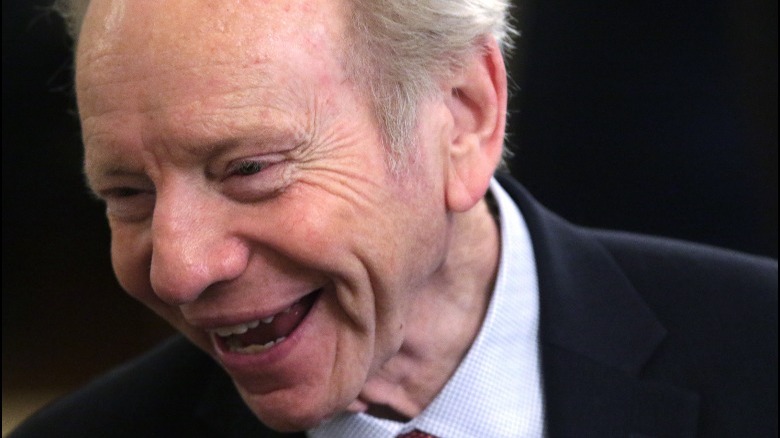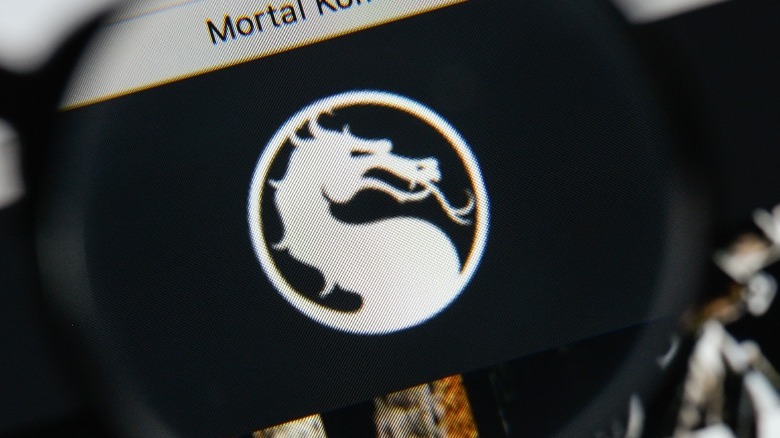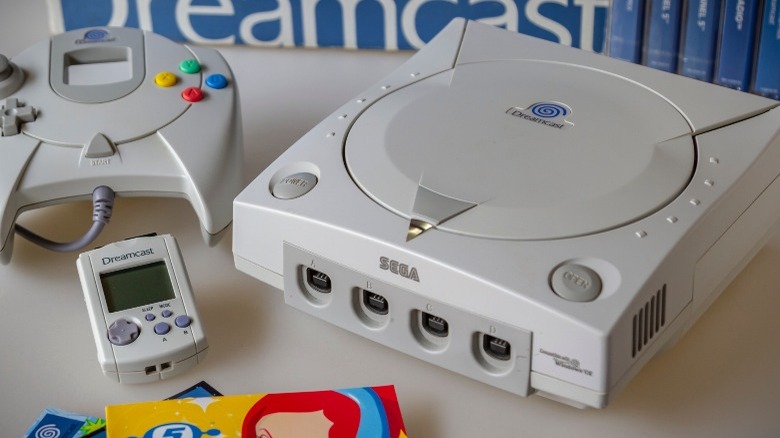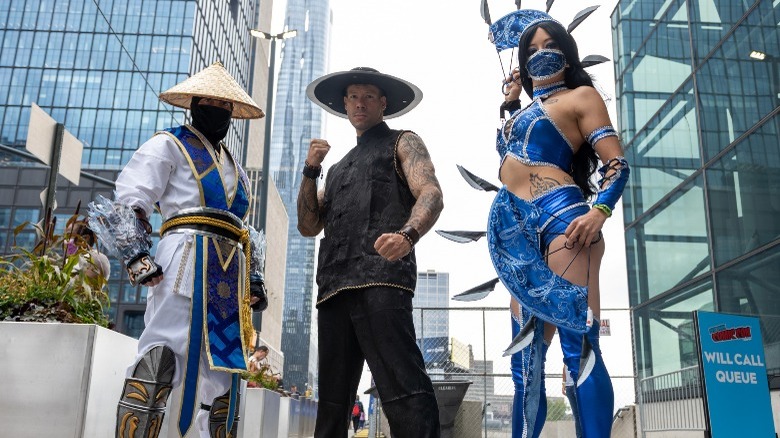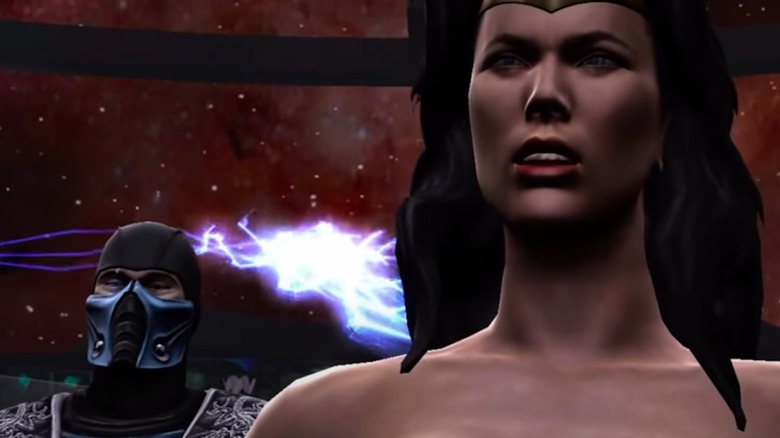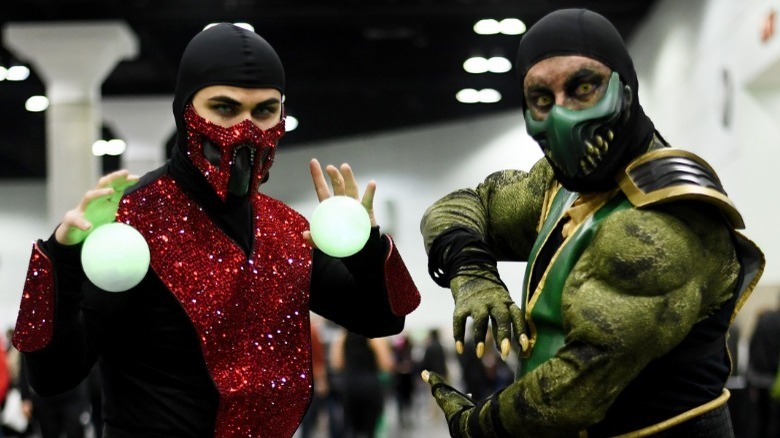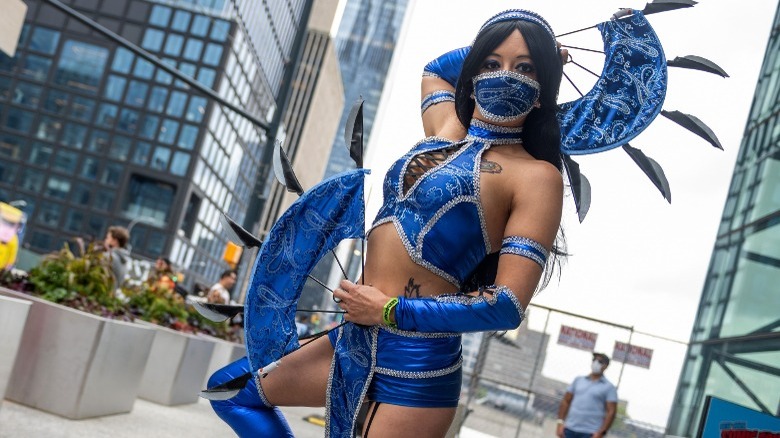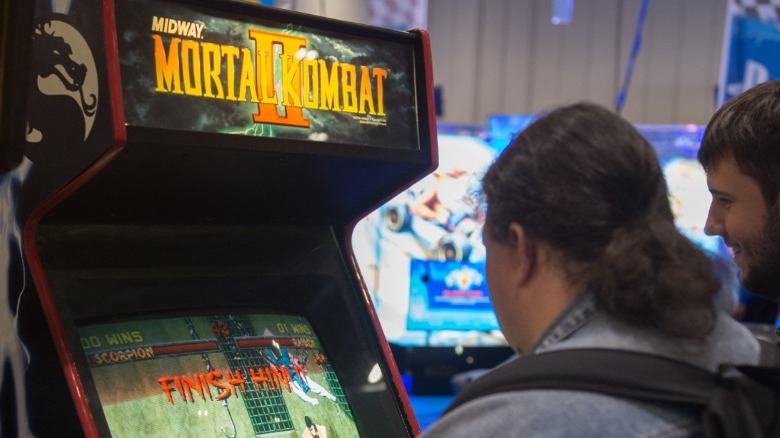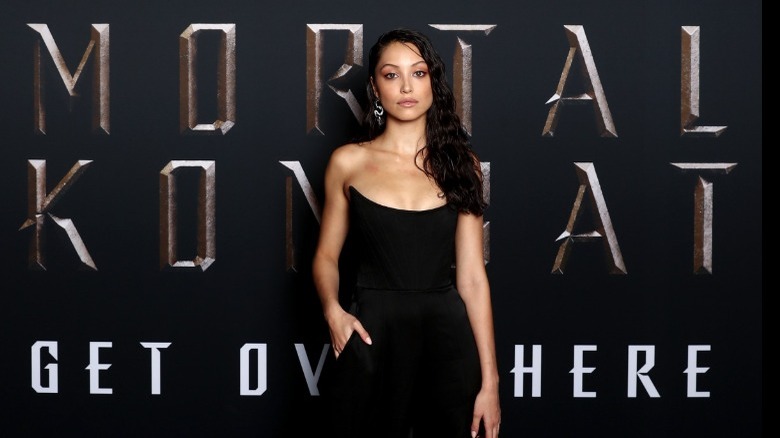The Untold Truth Of The Mortal Kombat Franchise
Back in the days of arcades, people were used to the sounds of quarters entering slots and people smashing buttons mixed in with synthetic noises. Then one day, voices from a game shouted "Fight," "Finish him," "Get over here," and other aggressive phrases, and everything changed. While there were games before it that replicated violence, none were brutal enough to show a person getting their head ripped off. It is October 1992, and "Mortal Kombat" has just changed the video game industry forever.
Though it was far from Midway's first game, the first "Mortal Kombat" did far more than just introduce audiences to Sub-Zero, Scorpion, Johnny Cage, Kano, Raiden, Sonya Blade, and Liu Kang to the world. Within a short period of time, "Mortal Kombat" changed the gaming scene, showing that graphic violence, gaming for a mature audience, and intense action were what many gamers wanted. But most importantly, it set in motion cultural and business changes that would revolutionize gaming.
First impressions, early reviews
To describe "Mortal Kombat" as a success would be an understatement. According to a 1994 article, "Video values: It's a whole new game for the industry," the game "earned more last year than the $300 million garnered by the box office hit 'Jurassic Park.'" This was in an era where arcades were white-hot and earning money hand-over-fist. The same article also mentioned that 1993 saw the "arcade sector of the video-game industry, which includes video games, pinball machines, and novelty games, had revenues of about $8 billion." On top of this, the home video game market hit $6.5 billion in revenue. The fact that "Mortal Kombat" was a financial leader during this time should tell you just how profitable it was.
Several fan polls placed "Mortal Kombat" at the top. A 1993 issue of "Electronic Games" found that "Mortal Kombat" was the favorite coin-operated arcade game. On top of that, arcade operators felt that from the perspective of valuing a game's physical equipment quality, "Mortal Kombat" was a number one game (per Play Meter). In other words, they felt it was the best game to get a return on one's investment.
It popularized hidden content
Marvel movies have trained audiences to know that at the end of a movie's credits, there will be an extra scene. Once upon a time, this was just a small Easter egg for hardcore fans, but now it's standard for blockbuster movies. Similarly, current gamers might expect all games to have hidden content and Easter eggs, but this wasn't always the case — this shift happened in large part because of the hidden content in "Mortal Kombat" games. Not only did this make the game more popular, but the gaming industry realized that replay value could be increased by adding a ton of Easter eggs, secret characters, and even games within games.
Writing for IGN about the franchise history of "Mortal Kombat," Travis Fahs discusses the evolution of hidden content in these installments: "While the first game featured one hidden character, the green ninja Reptile, Mortal Kombat 2 had three. Before long, there would be rumors swirling about 'Nudalities,' 'Animalities,' all manner of secret characters, and even hidden games." Of note, while "Animalities" would appear in the franchise, "Nudalities" never did.
In addition to installments having secret content, such as the chance to play "Pong," these hidden elements introduced characters that would become playable over the years. For example, MK1 had Reptile as a hidden figure, and he became playable in later games. Then, in MK2, Jade and Noob Saibot were introduced and had similar evolutions.
Enter politics
Almost every generation has to deal with various moral panics. A key reason is that many politicians are always looking for a wedge issue, while others seeking power will use (or even create) a controversial issue to get attention. And with the Satanic Panic of the 1980s still lingering in the 1990s but quickly fading, the appearance of "Mortal Kombat" became a lightning rod of controversy that politicians used to their advantage.
While "Street Fighter II" might have been just as popular as "Mortal Kombat" and came out a year before it, the realism that "Mortal Kombat" offered for its time — as well as the gore — got the attention of Joseph Lieberman, a then-U.S. Senator from Connecticut. After playing the game, Lieberman shared the following (via "The Ultimate History of Video Games"): "I was startled. It was very violent and, as you know, rewarded violence. And at the end, if you really did well, you'd get to decide whether to decapitate ... how to kill the other guy, how to pull his head off. And there were all sorts of blood flying around."
Lieberman was soon joined by a Senator from Wisconsin, Herbert Kohl, as well as Byron Dorgan from North Dakota. While only a handful of politicians took actual steps that threatened the video game industry, a congressional hearing was enough to scare this sector into self-regulating.
The ESRB is created
The U.S. government investigating entertainment industries is nothing new. Even though the film industry already had a self-regulatory board since the 1930s (the Motion Picture Production Code), it still had to deal with a government investigation in the 1940s. Specifically, starting in 1947, when the House Un-American Activities Committee tried to expose communists in Hollywood (via History). Something similar happened in the 1950s with comic books and in the 1980s when Parents Music Resource Center targeted the music industry (per Newsweek). In regards to comic books and music, both industries responded by creating their own self-censoring systems — comics developed the Comics Code Authority, and the music companies adopted the use of the "Parental Advisory" label.
Video game companies saw the writing on the wall and created the Entertainment Software Rating Board to avoid government regulation. This system had five rating categories — "Everyone," "Everyone 10+," "Teen," "Mature 17+," and "Adults Only 18+" — and 17 content descriptors. Per the Comic Book Legal Defense Fund, the ESRB not only created a rating system but "also provide[ed] advertising guidelines for how particular games should be marketed through media channels."
Of note, while these government hearings focused on "Mortal Kombat," they provided an unintentional arena for other combatants.
Nintendo versus SEGA
The Console War is the name given to the rivalry between Nintendo and SEGA that occurred as SEGA entered the console market that had been dominated by Nintendo. As Blake J. Harris wrote in his book, "Console Wars: Sega, Nintendo, and the Battle that Defined a Generation," the conflict between the two companies "was vicious, relentless, and highly profitable, eventually sparking a global corporate war that would be fought on several fronts: from living rooms and schoolyards to boardrooms and Congress."
When members of Congress moved to use "Mortal Kombat" to go after the gaming industry, both Nintendo and SEGA saw an opportunity. Nintendo responded by altering "Mortal Kombat" so that the color of blood was changed from red to green in an attempt to minimize the game's gore, while SEGA kept their version of the game as graphic as the arcade version.
Basically, Nintendo used the moral panic surrounding "Mortal Kombat" to make itself look like the more family-friendly game system. In the short run, things worked for SEGA. After all, "the SEGA Genesis version of 'Mortal Kombat' outsold the Super Nintendo version five-to-one" (per BBC). However, in the long run, Nintendo won because while Nintendo is still making consoles, SEGA stopped in the early 2000s because it could no longer compete.
Though "Mortal Kombat" was a weapon used by SEGA and Nintendo against one another and was the subject of a Congressional hearing, the game would also find itself at the center of several lawsuits.
Court battles
One of the many things that happens when something becomes incredibly successful is that lawsuits get filed. Under the ownership of Midway Games, "Mortal Kombat" found itself the subject of three lawsuits.
The most tragic cause of these lawsuits stems from a stabbing in 1997. A 13-year-old was stabbed by a friend who died from the injury, and the mother claimed that the attacker was motivated by playing "Mortal Kombat." It was one of the many lawsuits filed because adults believed that games, comic books, or other entertainment inspired violence (per a court document).
The other two lawsuits dealt with people who worked on the game wanting a larger piece of the pie once "Mortal Kombat" became a hit. One case started in 1996 and was started by Daniel Pesina, who modeled the characters of Johnny Cage, Scorpion, Sub-Zero, Noob Saibot, Reptile, and Smoke in the first and second installments of the game (via Leagle). Per Epstein, Drangel, Bazerman, & James, the other began in 1997 and featured Philip Ahan (the actor for Shang Tsung), Elizabeth Malecki (the model for Sonya Blade), and Katalin Zamiar (who portrayed Kitana, Mileena, and Jade). Both cases centered on the idea that since they had only modeled for the arcade versions, they hadn't been fairly compensated for the home console releases. The courts ruled in favor of Midway each time.
Mortal Kombat vs. DC Universe
There is a bittersweet nature about "Mortal Kombat vs. DC Universe." Though a success, it would not be enough to keep Midway from going under (we'll discuss that next). And despite this video game crossover appearing to be a cash grab at first, it was so well made that it left both franchises better off.
A key aspect of this game that sets it apart from previous "Mortal Kombat" installments is that it has an incredible story mode. As Mitchell Saltzman wrote for IGN, "It was also one of the first fighting games to introduce a four-hour-long, fully acted and motion captured story mode." The motivation behind a robust story mode stemmed from the creative team wanting to create a "Mortal Kombat" gaming experience that offered more than just fight scenes. So the story explained how the characters from the DC Comics and Mortal Kombat franchises could interact with one another and why their power levels were so different, all while creating a narratively immersive experience.
And this gambit worked. It not only resulted in the game selling nearly 2 million copies, but it also set a new foundation for future installments of the franchise.
Midway dies — enter NetherRealm
Despite the popularity of "Mortal Kombat," its sales alone could not save Midway Games from bankruptcy. As reported by Game Developer, 1999 was the last year that Midway turned a profit, and it only managed to generate "an operating profit of $8.3 million, way down from 1998's $65 million." According to Game Developer's Kris Graft, a key reason why Midway failed was that "it never really broke free of its admirable but stifling coin-op roots, and failed to become a true top-tier home console competitor."
The company's losses and debt only piled up. And despite news of "Mortal Kombat vs. DC Universe" being a top-selling game, by January 2009, Midway announced that it had a debt of $240 million (per GameSpot). Ultimately, Midway formally filed for bankruptcy in February 2009. Given the success it found working with the Mortal Kombat franchise, Warner Bros. swooped in and quickly purchased everything related to "Mortal Kombat" (via Kotaku). The original Midway studio was initially renamed Warner Chicago before finally being called NetherRealm Studios.
While Midway Games does live on in a manner, it's an important reminder that even companies with a successful product can fail.
More court battles
Sadly, Midway Games would not die peacefully thanks to Lawrence Kasanoff, who was an executive producer on the "Mortal Kombat" films and television shows. Per Escapist Magazine, Kasanoff claimed in a 2009 lawsuit that his "Mortal Kombat" movie took the franchise's "flat, cookie-cutter characters" and turned them into the complex mythology that defines the series today.
Kasanoff claimed responsibility for the "Mortal Kombat" website, the "Mortal Kombat" live stage show, a "Mortal Kombat: Behind the Dragon" television special, the soundtrack to the film, an animated special, the "Ultimate Guide to Mortal Kombat" CD-ROM, and various other things, per Escapist Magazine.
Kasanoff also claimed to be owed over $9 million in back royalties. In the end, Warner Bros. won. While Kasanoff was awarded $14,000, Judge Ronald M. Sohigian declared Warner Bros. the "prevailing party" that won where it mattered (via The Hollywood Reporter). Moreover, the end of this court battle allowed Warner and NetherRealm to finally move forward with new "Mortal Kombat" movies and related multimedia content.
A legacy of diversity
"Mortal Kombat" was initially criticized for promoting negative stereotypes (via Wired). However, as the franchise has evolved and the game can be put in context with the 1990s, new scholarship now argues that MK1 helped promote diversity.
To start, the first "Mortal Kombat" only had seven characters, and one of them was a woman — Sonya Blade, played by Elizabeth Malecki. Another was Liu Kang, played by Korean-American Ho-Sung Pak. Additionally, while this was not highlighted in the initial marketing materials for the games, brothers Carlos Pesina (who played Raiden) and Daniel Pesina (who played Johnny Cage, Scorpion, Sub-Zero, and Reptile) are both Hispanic.
Not only did the first "Mortal Kombat" have an incredibly diverse cast, but characters from non-white populations continued to appear as the series aged. And outside of race, the franchise has grown to be seen as having feminist elements. For instance, in a 2001 court case, a U.S. Judge named Richard Posner highlighted how the game promotes equality.
"Although violent video games appeal primarily to boys, the record contains, surprisingly, a feminist violent video game ... A man and a woman are dressed in vaguely medieval costumes, and wield huge swords. The woman is very tall, very fierce, and wields her sword effortlessly," Posner wrote. "The game is feminist in depicting a woman as fully capable of holding her own in violent combat with heavily armed men." Basically, the franchise went from being described as sexist to viewed as empowering to women.
It normalized games for adults
Prior to "Mortal Kombat," video games were seen as entertainment for kids. After all, the most popular games of the 1980s were "Pac-Man," "Tetris," "Super Mario Bros." and related franchise installments like "Duck Hunt," "Donkey Kong," and "The Legend of Zelda." These were games that were all-ages friendly and created the expectation that the video game medium was inherently safe for kids.
The brutality of "Mortal Kombat" and its graphic nature pushed the industry and customers to accept that some video games could be made only for adults and still be extremely popular. Writing about this shift for the Smithsonian Magazine, Kat Eschner noted, "Although gaming had previously been thought of as a pursuit for children, video game designers were beginning to acknowledge an adult market for the games. But satisfying adult interests meant making games that many parents thought weren't appropriate for n-year-olds."
A result of this realization is that some of the biggest video games since "Mortal Kombat" were designed for adults and are not suitable for children.
It remains a pop culture touchstone
According to Ed Boon, "Mortal Kombat" was initially built by four people in less than one year. "You can imagine what that was like for just four guys to experience. After that, we started a roller-coaster ride that we're still riding," Boon told Nintendo: The Official Magazine in 2007.
For a game that was built with a team of four, it is amazing to see the legacy and relevancy this franchise still has. Not only have there been "Mortal Kombat" toys, clothing, television shows, web series, and movies, but there was also a stage show. More than that, "Mortal Kombat" became more than just a form of entertainment for gamers — it's a touchstone present in all of pop culture.
As Reyan Ali wrote for Complex in 2012, "Years ago, MK1 became a phenomenon far outside gaming circles alone. Its name has become recognizable enough to be name-dropped on sitcoms ('Malcolm in the Middle' and 'Married ... With Children'), found in movies (Christian Slater plays MK4 in 'Very Bad Things'), and used as part of cultural studies (see Justine Cassell and Henry Jenkins' book 'From Barbie to Mortal Kombat: Gender and Computer Games')."
Even outside of being referenced, many of the characters are iconic, and the game's catchphrases are now part of everyday vernacular. In other words, for a game that is focused on fatalities, "Mortal Kombat" has had a tremendous life, and it still has decades to go.

